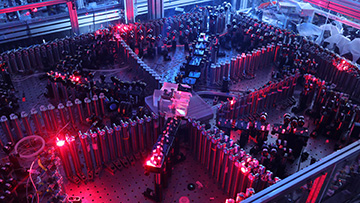![]()
An all-photonic quantum computer, Jiuzhang, which involves the interference of entangled photons passed through a network of beam splitters and mirrors, can solve one task designed to test quantum advantage, boson sampling, in a time 14 orders of magnitude faster than a classical supercomputer. [Image: Yi-Han Luo, USTC]
In the past several years, the headline news for quantum computing has tended to cluster around a few exotic platforms. These have included, for example, machines whose quantum bits (qubits) take the form of supercooled, superconducting circuits, as with the Google “Sycamore” device that late last year, to great fanfare, reported evidence of so-called quantum supremacy over classical machines. Other contenders include systems built on trapped ions or atoms, which have earned their stripes in simulations of complex physical quantum dynamics.
Next to these quantum stars, another family of systems—those relying entirely on photons to solve quantum problems—have sometimes seemed like the Rodney Dangerfields of the quantum-computing scene, getting little respect. A new result from China could change that perception. In an engineering tour de force, a team led by OSA Fellows Jian-Wei Pan and Chao-Yang Lu of the University of Science and Technology of China (USTC) has demonstrated an all-photonic quantum computer, dubbed “Jiuzhang,” that was able to solve, in a blistering three and one-half minutes, a problem that would have taken an estimated 2.5 billion years on a classical supercomputer (Science, doi: 10.1126/science.abe8770).
The accomplishment reportedly marks the first robust demonstration of quantum supremacy (also referred to as quantum advantage) on an all-photonic machine—indeed, possibly on any quantum computer, given the doubts that have been raised in some quarters regarding whether the claim for the Google machine will actually hold up. Granted, unlike Google Sycamore, the Jiuzhang machine is not programmable—and it solves a problem that only a specialist in quantum information could love. But it’s likely to attract new attention to photonic platforms as serious contenders in the quantum-computing race.
Dizzying dimensionality
Soon after Google’s announcement in October 2019 that Sycamore had achieved a significant quantum advantage over classical machines, some chinks started showing up in the armor. The Google team had claimed that a problem tackled in three minutes by Sycamore, involving calculating quantum probabilities in a state space with a dizzying 253 dimensions, would have taken 10,000 years on a classical supercomputer. Soon afterward, however, the creator of the supercomputer in question, IBM, argued that classical machines, armed with the right algorithm, could do the calculation in a matter of days, not years.
For its own demonstration of quantum supremacy, the team in China chose a different problem—so-called boson sampling, considered a fundamental test of quantum advantage. The specific variant of boson sampling trialed by the researchers involves injecting nonclassical “squeezed” light into a network of optical components, creating highly random entangled states that are subsequently measured by single-photon detectors. As the system increases in complexity and in the number of possible paths, the entangled-state dimension grows exponentially, easily outstripping the ability of the best classical algorithms to keep up.
Complex network
The Jiuzhang experiment entailed a complex setup encompassing a pulsed laser source, 25 nonlinear crystals, 300 beam splitters, 75 mirrors and 100 single-photon detectors. [Image: Han-Sen Zhong, USTC] [Enlarge image]
To both create and solve this hairy problem, the USTC researchers put together a complex tabletop setup. The chain begins with laser pulses, churned out at a 250-kHz repetition rate, that are split into 13 paths and pass through 25 periodically poled KTP crystals to produce 25 squeezed states (converted into 50 indistinguishable states through clever encoding). The light passes into a network of 300 beam splitters and 75 mirrors that effectively create a 100-mode, 3D interferometer for the entangled system.
A set of 100 high-efficiency single-photon detectors samples the interferometer output, generating a click for each detected event. The potential number of click-pattern distributions in the detectors scales exponentially with the number of clicks reported.
The USTC team’s platform—operating at room temperature and carefully phase-locked end-to-end, to stabilize it “in the presence of various environmental perturbations”—was able to generate up to 76 output photon clicks. That’s equivalent to a state-space dimension of 1030. The design of the system effectively means that the click pattern itself provides the solution to the boson-sampling problem, in a run time of around 200 seconds. The team calculated that the best classical algorithms, running on China’s Sunway TaihuLight supercomputer, would take 8×1016 seconds to calculate the same number of samples. That’s 2.5 billion years—more half of the age of the solar system.
Narrow application—for now
While a hugely impressive technical achievement, the claim of quantum advantage for this all-photonic device does raise a number of obvious questions. One, as with any such claim, is how to check it, since classical computers are by definition not up to doing the job on any realistic time frame.
To address the problem, the team took an approach that “relies on gathering circumstantial evidence while ruling out possible [alternative] hypotheses.” In the current case, the evidence involved other test runs using variations such as thermal light states, distinguishable photons and a uniform distribution. All suggested that the result produced by the Jiuzhang experiment were valid, and ruled out alternative hypotheses.
Another question is: Quantum advantage for what? Boson sampling is an arcane problem that’s in some sense native to a platform such as this, without clear applications for more practical computing. (To be fair, a few recent papers, have suggested that Gaussian boson sampling could be useful in certain problems in graph theory and in simulating molecular vibronic spectra.) And unlike Google’s Sycamore, Jiuzhang—named after a classic Chinese mathematics text—isn’t programmable for different tasks (at least not yet).
Nonetheless, the accomplishment highlights the potential for all-photonic quantum computing to blow past classical approaches. For this problem, at least, experts believe it’s unlikely that a competitive classical algorithm will ever be found.

